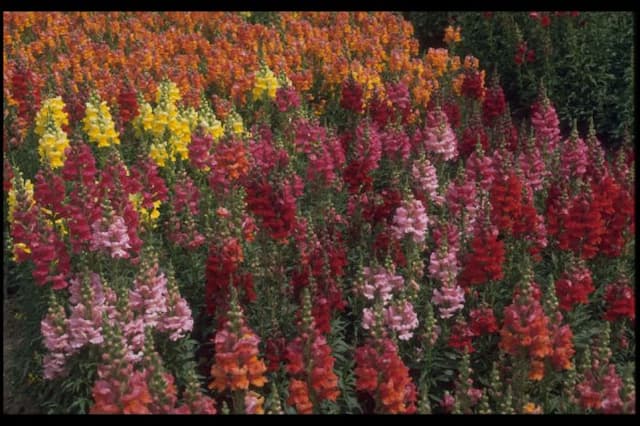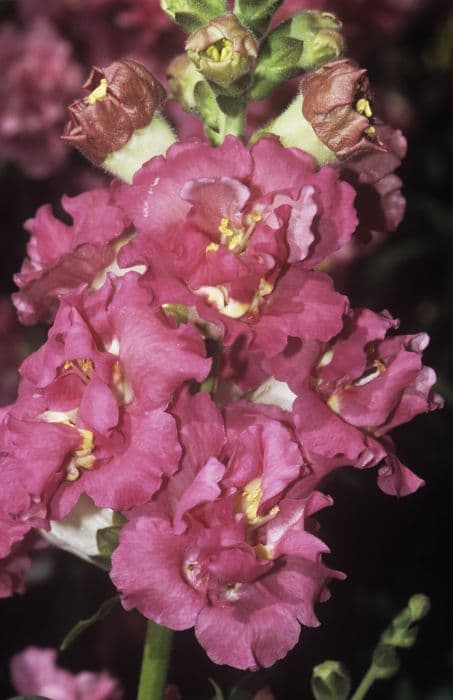Beardtongue Penstemon 'Precious Gem'

ABOUT
Penstemon 'Precious Gem' is an attractive perennial plant that boasts a plethora of tubular flowers. These blossoms display a vibrant spectrum of colors, typically in rich shades of purple, pink, or red, often with contrasting throats that may be white or a lighter shade. The flowers are densely arranged along tall, upright spikes that rise gracefully above the foliage. The leaves of the 'Precious Gem' are narrow and elongated, with a smooth or slightly serrated edge, and they have a lush, green appearance that forms a clump or mound, providing an appealing backdrop for the striking flowers. The foliage may also have a fine layer of hairs, giving it a slightly rough texture to the touch. This Penstemon variety is known for its ornamental value in garden landscapes, attracting hummingbirds and butterflies with its nectar-rich blooms. The overall visual effect is one of elegance and vibrant color, making it a prized addition to flower borders and garden beds.
About this plant
 Names
NamesFamily
Plantaginaceae
Synonyms
Beardtongue, Precious Gem Penstemon
Common names
Penstemon 'Precious Gem'.
 Toxicity
ToxicityTo humans
The Beardtongue (Penstemon 'Precious Gem') is generally not considered toxic to humans. There are no widely recognized symptoms of poisoning for humans from ingesting any part of this plant, as it is not known to contain any significant toxins that affect human health when touched or ingested.
To pets
The Beardtongue (Penstemon 'Precious Gem') is not considered toxic to pets either. It is typically seen as a safe plant in gardens where pets are present and does not cause harm if pets happen to ingest parts of it. There are no specific symptoms of poisoning from the Beardtongue as it is not a poisonous plant to pets.
 Characteristics
CharacteristicsLife cycle
Perennials
Foliage type
Deciduous
Color of leaves
Green
Flower color
Varies
Height
2-3 feet (60-90 cm)
Spread
1-2 feet (30-60 cm)
Plant type
Herb
Hardiness zones
5
Native area
North America
Benefits
 General Benefits
General Benefits- Attracts Pollinators: Provides a food source for bees and butterflies, which are essential for pollination.
- Drought Tolerant: Adapts well to dry environments, reducing the need for frequent watering.
- Low Maintenance: Requires minimal care once established, making it ideal for gardeners of all experience levels.
- Long Blooming Season: Offers a prolonged display of flowers, often from late spring to early fall.
- Aesthetic Appeal: Adds vibrant color and visual interest to garden landscapes and borders.
- Cold Hardy: Can endure cooler temperatures and is suitable for growing in a wide range of climates.
- Deer Resistant: Less likely to be browsed by deer, which can be a common garden nuisance.
- Soil Versatility: Capable of growing in various soil types, though it prefers well-drained soils.
- Non-Invasive: Unlike some plants, it is not known to aggressively take over garden spaces.
- Habitat Enrichment: Contributes to the biodiversity of the area, supporting local ecosystems.
 Medical Properties
Medical PropertiesThis plant is not used for medical purposes.
 Air-purifying Qualities
Air-purifying QualitiesThis plant is not specifically known for air purifying qualities.
 Other Uses
Other Uses- Artistic Inspiration: Artists and photographers often use the vibrant colors of Penstemon, also known as Beardtongue, as a subject for their work, capturing its aesthetic in various forms of media.
- Education: Beardtongue can be used in educational gardens to teach about pollination and native plant gardening, illustrating the relationships between native flora and pollinator fauna.
- Culinary Garnish: While not widely recognized for culinary use, the blossoms of Beardtongue can be used as an edible garnish for salads or desserts, adding a splash of color.
- Dye Production: The flowers of Beardtongue can be used in the production of natural dyes for fabrics or crafts, contributing a range of colors depending on the processing methods.
- Garden Design: With its upright form and variety of colors, Beardtongue can be used to create striking vertical elements in landscape design.
- Eco-friendly Confetti: Dried petals of Beardtongue can be used as a biodegradable confetti alternative for outdoor celebrations, reducing environmental impact.
- Ink Making: The pigment from the flowers of Beardtongue can be used to create natural inks for art or calligraphy purposes.
- Fragrance Extraction: Although not commonly known for its scent, the subtle fragrance of Beardtongue flowers could be captured and used in homemade potpourri mixes.
- Plant Stakes: The stiff stems of Beardtongue, after the plant has died back, can be repurposed as natural plant stakes for supporting other garden plants.
- Crafting Material: Dried Beardtongue flowers and seed pods can be incorporated into decorative crafts such as wreaths, floral arrangements, or as embellishments in scrapbooking.
Interesting Facts
 Feng Shui
Feng ShuiThe Beardtongue is not used in Feng Shui practice.
 Zodiac Sign Compitability
Zodiac Sign CompitabilityThe Beardtongue is not used in astrology practice.
 Plant Symbolism
Plant Symbolism- Love and Admiration: The Penstemon, also known as Beardtongue, is often associated with feelings of affection and the communication of deep admiration, much like its vibrant blossoms reaching out.
- Diversity and Boldness: With its various colors and patterns, Beardtongue stands for the beauty of diversity and the courage to be unique or to stand out from the crowd.
- Endurance and Hardiness: Penstemon's ability to thrive in challenging environments symbolizes strength, resilience, and the capacity to endure hardships.
- Healing: Historically, some species of Beardtongue have been used in medicinal remedies, which imbues the plant with the symbolic meaning of healing and restoration.
 Water
WaterBeardtongue generally prefers moderate moisture and should be watered deeply and less frequently to encourage deep root growth. During the growing season, provide about one inch of water per week, either from rainfall or manual watering. Adjust the amount based on the weather conditions; during prolonged dry spells, it might be necessary to water twice a week. Always allow the top inch of soil to dry out between waterings to prevent root rot. Overwintering plants require less water, and one should reduce watering frequency to when the soil is dry several inches down.
 Light
LightBeardtongue thrives in full sun conditions, meaning at least six to eight hours of direct sunlight per day. It performs best when planted in a location that receives morning sunlight and partial afternoon shade, especially in regions with hot summers. However, it can also tolerate and bloom in partial shade, although flowering may be reduced.
 Temperature
TemperatureBeardtongue prefers temperatures in the range of 60°F to 85°F but can tolerate temperatures as low as 20°F and as high as 90°F. The ideal growth temperatures for Beardtongue are moderate, between 65°F and 75°F. Extreme temperatures below 20°F or above 90°F may cause stress or damage to the plant.
 Pruning
PruningBeardtongue should be pruned to remove spent flower spikes and to shape the plant, which encourages new blooms and maintains plant health. The best time to prune is right after the main flowering period has ended, usually in late summer or early fall. Cut back by about one-third to promote bushy growth and potentially a second flush of flowers in certain climates.
 Cleaning
CleaningAs needed
 Soil
SoilBeardtongue 'Precious Gem' thrives in well-draining soil with a pH of 6.0 to 8.0. A mix of loam, sand, and compost is ideal to ensure proper drainage and fertility. Mulching helps maintain moisture and control weeds.
 Repotting
RepottingBeardtongue 'Precious Gem' does not need frequent repotting as it is typically grown as a perennial in gardens. Repotting every 2-3 years or when rootbound is sufficient.
 Humidity & Misting
Humidity & MistingBeardtongue 'Precious Gem' is tolerant of a wide range of humidity conditions and does not require high humidity levels to thrive.
 Suitable locations
Suitable locationsIndoor
Place in bright indirect light, avoid overwatering, and ensure good air flow.
Outdoor
Plant in sunny spot, well-draining soil, and water moderately.
Hardiness zone
4-9 USDA
 Life cycle
Life cycleThe life cycle of the Penstemon 'Precious Gem', or Beardtongue, begins with seed germination, typically after experiencing a period of stratification to break dormancy. This is followed by the development of a rosette of basal leaves as the seedling establishes itself. As it matures, the plant sends up flowering stalks bearing bell-shaped flowers that are attractive to pollinators, crucial for the next stage of reproduction. Once pollinated, the flowers develop into small capsules containing numerous tiny seeds. After seed dispersal, the parent plant continues to grow and may enter a period of dormancy during colder months, perennating through its root system. This perennial plant will resume growth in the following spring, repeating its reproductive cycle.
 Propogation
PropogationPropogation time
Spring-Early Summer
Propogation: Penstemon 'Precious Gem', commonly known as 'Precious Gem' Beardtongue, is commonly propagated by seed or by cuttings. The most popular method for propagating this particular cultivar is by cuttings, typically during the late spring to early summer months. To propagate by cuttings, one would select healthy, non-flowering stems and cut them to about 4 to 6 inches (approximately 10 to 15 centimeters) in length. These cuttings should then have the lower leaves removed and be dipped in a rooting hormone before being planted in a well-draining soil mix. The soil should be kept moist but not waterlogged, and the cuttings should be placed in a warm area with bright, indirect light. Roots usually develop within a few weeks, after which the new plants can be gradually acclimatized to outdoor conditions before being planted in their permanent location.





![Snapdragon [Pretty in Pink]](/_next/image?url=https%3A%2F%2Fplants-admin.emdemapps.com%2Fimages%2Fplants%2F%2Fimages%2F604b5cb3b5385.png&w=640&q=75)



